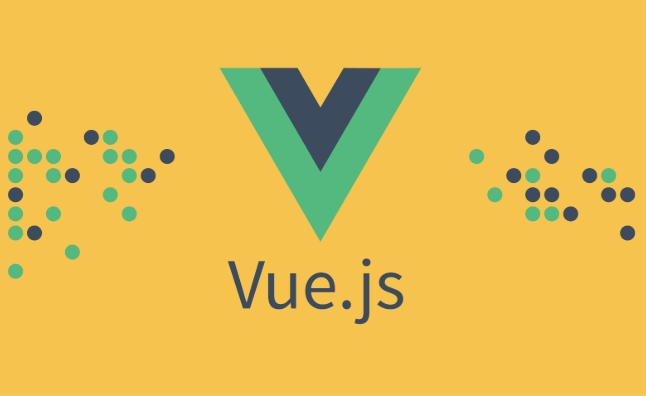Implementing drag-and-drop lists in Vue can be done through the HTML5 drag-and-drop API or third-party libraries. 1. When using native API, add draggable attributes and dragstart, dragover, drop events to the list items, record indexes in dragstart, block default behavior in dragover, and exchange positions in drop; 2. Combining Vue responsive data, use the splice method to update the array order to trigger view refresh; 3. Optionally use vuedraggable and other libraries to simplify development, and implement drag and drop sorting through v-model binding data, improve efficiency and support complex functions.

It is actually not difficult to implement a drag-and-drop list in Vue. The key is to understand the triggering mechanism of drag-and-drop events and how to combine Vue's responsive features to update data. Below I will divide it into several steps to take you to implement a basic but practical draggable list step by step.

Use HTML5 native drag and drop API to implement basic drag and drop functions
HTML5 provides a native Drag and Drop API, which is ideal for building simple drag and drop interactions. We can control the dragging behavior through draggable attribute and a series of events (such as dragstart , dragover , drop , etc.).
Key points:
- Add
draggable="true"to each list item. - Record the index of the currently dragged item in
dragstartevent. - Block default behavior in
dragoverto allow placement. - Swap or insert element positions in
dropevent.
The sample code structure is as follows:

<template>
<div>
<div
v-for="(item, index) in items"
:key="item.id"
draggable="true"
@dragstart="onDragStart(index)"
@dragover.prevent
@drop="onDrop(index)"
>
{{ item.text }}
</div>
</div>
</template>Combined with Vue's responsive data update view
The most important step in the drag and drop process is to update the data and have Vue refresh the view automatically. You can use splice() method of the array to move the position of the element.
Example method:
data() {
return {
Items: [
{ id: 1, text: 'Item 1' },
{ id: 2, text: 'Item 2' },
{ id: 3, text: 'Item 3' }
],
draggedIndex: null
};
},
methods: {
onDragStart(index) {
this.draggedIndex = index;
},
onDrop(dropIndex) {
const movedItem = this.items.splice(this.draggedIndex, 1)[0];
this.items.splice(dropIndex, 0, movedItem);
this.draggedIndex = null;
}
}This enables automatic update of the array order after dragging and dropping, and Vue will automatically re-render the list.

Optional: Use third-party libraries to simplify development process
If you need more complex drag and drop functions, such as cross-list drag and drop, animation effects, etc., you can consider using some mature Vue drag and drop component libraries, such as:
These libraries encapsulate most of the underlying logic and are very convenient to use. For example, use vuedraggable :
npm install vuedraggable
Then introduce and use it in the component:
<template>
<draggable v-model="items">
<div v-for="item in items" :key="item.id">
{{ item.text }}
</div>
</draggable>
</template>
<script>
import draggable from 'vuedraggable';
export default {
components: { draggable },
data() {
return {
Items: [
{ id: 1, text: 'Item 1' },
{ id: 2, text: 'Item 2' },
{ id: 3, text: 'Item 3' }
]
};
}
};
</script> Basically that's it.
From native APIs to mature component libraries, you can choose the right way based on project complexity. Although the native implementation is a little bit cumbersome, it helps to understand the drag and drop principle; using the library can save time and improve efficiency.
The above is the detailed content of How to build a draggable list in Vue?. For more information, please follow other related articles on the PHP Chinese website!

Hot AI Tools

Undress AI Tool
Undress images for free

Undresser.AI Undress
AI-powered app for creating realistic nude photos

AI Clothes Remover
Online AI tool for removing clothes from photos.

Clothoff.io
AI clothes remover

Video Face Swap
Swap faces in any video effortlessly with our completely free AI face swap tool!

Hot Article

Hot Tools

Notepad++7.3.1
Easy-to-use and free code editor

SublimeText3 Chinese version
Chinese version, very easy to use

Zend Studio 13.0.1
Powerful PHP integrated development environment

Dreamweaver CS6
Visual web development tools

SublimeText3 Mac version
God-level code editing software (SublimeText3)
 How to develop a complete Python Web application?
May 23, 2025 pm 10:39 PM
How to develop a complete Python Web application?
May 23, 2025 pm 10:39 PM
To develop a complete Python Web application, follow these steps: 1. Choose the appropriate framework, such as Django or Flask. 2. Integrate databases and use ORMs such as SQLAlchemy. 3. Design the front-end and use Vue or React. 4. Perform the test, use pytest or unittest. 5. Deploy applications, use Docker and platforms such as Heroku or AWS. Through these steps, powerful and efficient web applications can be built.
 How to work and configuration of front-end routing (Vue Router, React Router)?
May 20, 2025 pm 07:18 PM
How to work and configuration of front-end routing (Vue Router, React Router)?
May 20, 2025 pm 07:18 PM
The core of the front-end routing system is to map URLs to components. VueRouter and ReactRouter realize refresh-free page switching by listening for URL changes and loading corresponding components. The configuration methods include: 1. Nested routing, allowing the nested child components in the parent component; 2. Dynamic routing, loading different components according to URL parameters; 3. Route guard, performing logic such as permission checks before and after route switching.
 What is the significance of Vue's reactivity transform (experimental, then removed) and its goals?
Jun 20, 2025 am 01:01 AM
What is the significance of Vue's reactivity transform (experimental, then removed) and its goals?
Jun 20, 2025 am 01:01 AM
ReactivitytransforminVue3aimedtosimplifyhandlingreactivedatabyautomaticallytrackingandmanagingreactivitywithoutrequiringmanualref()or.valueusage.Itsoughttoreduceboilerplateandimprovecodereadabilitybytreatingvariableslikeletandconstasautomaticallyreac
 What are the core differences between Vue.js and React in componentized development?
May 21, 2025 pm 08:39 PM
What are the core differences between Vue.js and React in componentized development?
May 21, 2025 pm 08:39 PM
The core differences between Vue.js and React in component development are: 1) Vue.js uses template syntax and option API, while React uses JSX and functional components; 2) Vue.js uses responsive systems, React uses immutable data and virtual DOM; 3) Vue.js provides multiple life cycle hooks, while React uses more useEffect hooks.
 How can internationalization (i18n) and localization (l10n) be implemented in a Vue application?
Jun 20, 2025 am 01:00 AM
How can internationalization (i18n) and localization (l10n) be implemented in a Vue application?
Jun 20, 2025 am 01:00 AM
InternationalizationandlocalizationinVueappsareprimarilyhandledusingtheVueI18nplugin.1.Installvue-i18nvianpmoryarn.2.CreatelocaleJSONfiles(e.g.,en.json,es.json)fortranslationmessages.3.Setupthei18ninstanceinmain.jswithlocaleconfigurationandmessagefil
 Vue responsive principle and solution to not trigger view updates when array updates?
May 20, 2025 pm 06:54 PM
Vue responsive principle and solution to not trigger view updates when array updates?
May 20, 2025 pm 06:54 PM
When Vue.js handles array updates, the view is not updated because Object.defineProperty cannot directly listen to array changes. Solutions include: 1. Use the Vue.set method to modify the array index; 2. Reassign the entire array; 3. Use the rewritten mutation method of Vue to operate the array.
 What are the benefits of using key attributes (:key) with v-for directives in Vue?
Jun 08, 2025 am 12:14 AM
What are the benefits of using key attributes (:key) with v-for directives in Vue?
Jun 08, 2025 am 12:14 AM
Usingthe:keyattributewithv-forinVueisessentialforperformanceandcorrectbehavior.First,ithelpsVuetrackeachelementefficientlybyenablingthevirtualDOMdiffingalgorithmtoidentifyandupdateonlywhat’snecessary.Second,itpreservescomponentstateinsideloops,ensuri
 How can you optimize the re-rendering of large lists or complex components in Vue?
Jun 07, 2025 am 12:14 AM
How can you optimize the re-rendering of large lists or complex components in Vue?
Jun 07, 2025 am 12:14 AM
Methods to optimize the performance of large lists and complex components in Vue include: 1. Use the v-once directive to process static content to reduce unnecessary updates; 2. implement virtual scrolling and render only the content of the visual area, such as using the vue-virtual-scroller library; 3. Cache components through keep-alive or v-once to avoid duplicate mounts; 4. Use computed properties and listeners to optimize responsive logic to reduce the re-rendering range; 5. Follow best practices, such as using unique keys in v-for, avoiding inline functions in templates, and using performance analysis tools to locate bottlenecks. These strategies can effectively improve application fluency.






